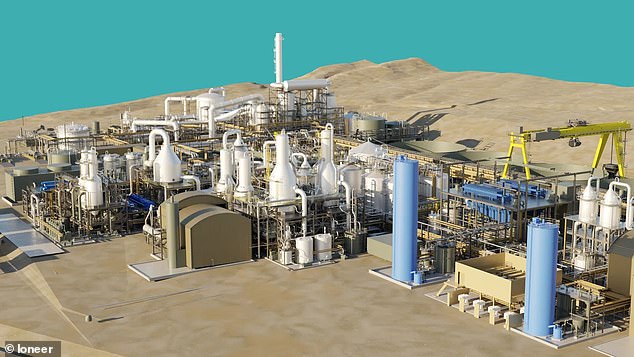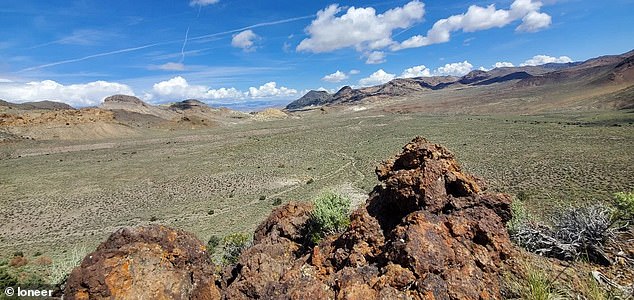Nevada ghost town to spearhead America’s new ‘gold’ rush as huge $3.4bn lithium mine gets greenlight
Approval has been granted for a major $3.4 billion lithium mine in a Nevada town that was once a bustling gold mining hotspot.
Rhyolite Ridge – home to just 675 people – is one of the poorest places in the US, but a new mine is expected to power 370,000 electric vehicles a year.
The Rhyolite Ridge Project is predicted to bring more than 500 jobs and $125 million in annual wages to the abandoned area.
The mine is the only lithium boron deposit in North America, allowing the U.S. to not only produce batteries but also use boron to make semiconductors.
The Biden administration has approved construction of the 7,000-acre mine to begin next year and production to begin in 2028.
“Nevada’s mining sector is critical to our economy, which is why I have worked across party lines to support it,” said Sen. Jacky Rosen (D-Nevada), who is running for Senate re-election, in a statement declaration.
“This will help us expand Nevada’s national role in critical mineral production and create hundreds of good-paying jobs while protecting critical landscapes and habitats.”
Rhyolite was once an important mining camp during the massive 1904 gold rush that killed 10,000 people, but the mines closed just a few years later.
Construction of the Rhyolite Ridge mines is expected to begin next year and lithium production will begin in 2028
The U.S. Department of Energy has approved a $700 million conditional loan for the Rhyolite Ridge Project, which has the potential to produce a total of 192,218 metric tons of lithium over 23 years.
Ioneer director Bernard Rowe told the Nevada Stream that the mine’s approval is “a milestone for the company,” adding that Rhyolite Ridge “is a very special mineral deposit” that will be critical to lithium production in North America.
“There’s nothing like it in the world,” Rowe said. ‘There is no other mine anywhere in the world that produces both lithium and boron on any significant scale. So this is a unique type of deposit, and that brings enormous benefits.’
Boron is also an important compound in EV batteries that improves longevity and stability and results in faster charging capabilities.
Finding both in the same deposit at such high levels is critical for domestic lithium production.
Several carmakers, including Ford, Toyota and Panasonic, have already reached an agreement with Ioneer – the company backing the project – to obtain lithium from the mine.
Ioneer claimed the mine will generate between $13 million and $31.5 million in annual government revenue once fully operational and provide enough lithium to power a total of 50 million electric vehicles over 20 years.
Ford has already said it will purchase about 34 percent of the mine’s lithium within the first five years.
“This approval is not only a significant victory for Nevada, but also for the ongoing efforts to ensure that made-in-America can mean mined in America,” said Rich Nolan, president and CEO of the National Mining Association.
The U.S. currently accounts for just two percent of global lithium, but federal officials are now trying to boost domestic lithium production.

The mining area will cover 7,000 hectares and produce 192,218 tonnes of lithium over the life of the mine
The Interior Department’s Bureau of Land Management (BLM) approved the permit for Rhyolite Ridge on Thursday after determining the mine would not drive the critically endangered Tiehm buckwheat flower to extinction amid environmental protests.
However, the approved permit says, “Exposure to hazardous materials, including petroleum from vehicles or equipment, runoff and leached elements could result from the proposed project.”
The Center for Biological Diversity responded within an hour of the announcement by giving 60 days’ notice of its intention to sue the federal government under the Endangered Species Act.
“By greenlighting this mine, the Bureau of Land Management is abdicating its duty to protect endangered species like Tiehm’s buckwheat and making a mockery of the Endangered Species Act,” said Patrick Donnelly, Great Basin director at the Center for Biological Diversity.
‘We need lithium for the energy transition, but there should be no price tag on that.’
The U.S. Fish and Wildlife Service has also concluded that the mining project will not impact the Tiehm buckwheat or its habitat and has protected approximately 350 acres as critical habitat for the wildflower.

Environmentalists are concerned the mine will cause a critically endangered wildflower to become extinct
Environmentalists have also raised concerns about the mine’s water consumption, protesting that it could worsen the region’s ongoing drought.
The amount of water used for lithium mining varies, but can range from several thousand to tens of thousands of acre-feet per year – one acre-foot of water is equivalent to 325,851 gallons.
Ioneer said it will use about 1.3 billion liters of water, but claims half of that will be recycled.
The company said the lithium carbonate particles are easily accessible, meaning it doesn’t have to dig deep into the Earth’s surface to extract the metal.
After extraction, the raw lithium ore is crushed to less than 20 millimeters and stacked in a series of leaching vessels, which are large containers made of wood or concrete.
Dilute sulfuric acid will be added to the barrels to remove the lithium and boron and will then be cooled in a crystallizer before impure elements, including aluminum and magnesium, are removed.
However, sulfuric acid can contaminate soil and water and pose a health risk to humans and animals.
Sulfuric acid is highly corrosive and is said to burn plants, birds, or animals exposed to it and cause respiratory irritation in humans, including immediate burning in the mouth and throat, headache, nausea, and vomiting.
Rowe argued that Ioneer has made significant concessions to protect the environment, including setting aside land to protect Tiehm buckwheat, taking steps to conserve water and moving waste storage out of culturally sensitive locations.
“The Rhyolite Ridge lithium mine project is essential to advancing the clean energy transition and fueling the economy of the future,” said Laura Daniel-Davis, BLM Acting Assistant Secretary.
“This project and the process we have undertaken demonstrates that we can pursue responsible, critical mineral development here in the United States while protecting the health of our public lands and resources.”
DailyMail.com has contacted Ioneer for comment.
